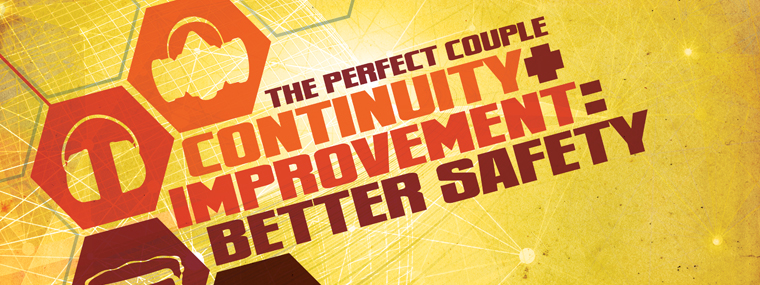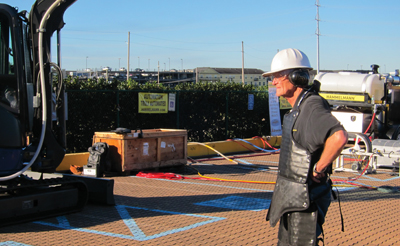
The Perfect Couple: Continuity + Improvement = Better Safety
By Diane M. Calabrese / Published February 2015

Editor’s Note: Alex Vannett with Brite Side Pressure Washing pointed out that in the November 2014 issue of CT|IWA in the article, “Paint and Coatings Removal,” on page 30, a photo that was used depicting a pressure washer operator not wearing proper PPE sent the wrong message about safety. Vannett is correct to note, “This photo sends the wrong message to the industry on the importance of safety. I would never suggest pressure washing without the use of proper PPE. That picture depicts an accident waiting to happen.” CT|IWA is thankful for the astute observations of Vannett and for the fact that he took time to let us know of his concerns. The aforementioned photo does indeed show a lack of proper PPE and CT|IWA wants to apologize for its use and encourage all involved in the industry to wear proper PPE at all times.
Safety and Personal Protective Equipment
More underrated than overused, the coupling of continuous and improvement sums up nicely the changes for the better that just keep coming in safety and personal protective equipment (PPE).
Some of the impetus for a safer work environment derives from government regulations to protect workers. Yet much of the motivation has a closer connection in the form of employers with a sincere interest in maintaining a safe workplace. Employers know and value their employees, and as a basic fact of life, they do not want team members to be injured in the course of doing their work.
 Also very much in the mix are manufacturers, who are designing products with the end user in focus at all times. Today, collaboration between the end user and design engineers is the norm. The result is good outcomes at each job site.
Also very much in the mix are manufacturers, who are designing products with the end user in focus at all times. Today, collaboration between the end user and design engineers is the norm. The result is good outcomes at each job site.
“We had contractors requesting a new suit that incorporated our TurtleSkin WaterArmor panels into overalls and a jacket,” says Leslie Richardson Weiss, who is in technical sales at Warwick Mills, Inc. in Ipswich, NH. And her company responded.
“We showed the new suit at the WJTA-IMCA show in October 2014,” says Richardson Weiss. “TurtleSkin WaterArmor is CE certified PPE for protecting waterjet operators from accidental swipes with pressures up to 40,000 psi. It has more than 75 documented ‘saves’ from injuries. Any time you can eliminate an injury to a worker, that’s a good outcome on a job site.”
Even low pressure equipment can result in injury to workers. The Centers for Disease Control and Prevention (CDC) warns that the seriousness of injuries from skin contact with 100 psi is too often overlooked because the fresh wound appears benign, when it may actually progress to infection and worse. CDC advises having any wound checked by a medical practitioner.
Of course, the better option is not to experience a wound. And wearing PPE reduces the risk of injury. PPE is a vital component of workplace safety. But the PPE must be a match for the job and for the employee.
The best-fitting PPE is still an encumbrance. Restricted movement leads to problems. (Astronauts practice and practice some more before undertaking a mechanical fix during a spacewalk—and yet the odd implement has gotten away from a gloved hand.)
Poor-fitting PPE may be such a hindrance to motion that it does not afford protection. (In the medical sphere, we all recall the problems nurses had with ill-fitting PPE and the vulnerability it created for them when they cared for a patient suffering from Ebola.)
Any use of PPE should be tied to a workplace safety program that evaluates the specific PPE necessary, as well as how to put on, take off, and maintain all protective wear. If PPE is designed to protect a worker from hazardous materials (e.g., chemical sprays, debris dislodged during high-pressure applications), consolidating and cleaning the PPE must be part of the safety plan from the start.
The Occupational Safety and Health Administration (OSHA) offers free, confidential, on-site consultations to assist employers in identifying hazards at worksites. The consultations are separate from enforcement.
Comprehensive Approach
Contractors are busy and often working on compressed schedules. Still, it’s important for them to take time to assess the need for PPE and to follow through using it. Just a one-time failure to wear non-slip boots could lead to a fall and a broken bone that takes the contractor off the job site for an extended period.
Loss of income, an increase in insurance premiums, and a citation (or penalty) from OSHA may all result from one workplace injury. If the injury could have been prevented with appropriate PPE, it is a particularly bad outcome.
“Helping people to understand the hazards of not wearing personal protective equipment is one of the biggest challenges in the pressure washing industry,” says Drew Harbour, the safety manager at Chappell Supply and Equipment in Oklahoma City, OK. “Safety glasses, steel-toed boots, and durable-palmed gloves are essential in the safe utilization of a pressure washer.”
We all have bad habits—whether it’s leaving a trail of empty teacups or not cleaning up our desk. We may shape up for a time and, then, we backslide. But some less-than-thought-through practices in the worksite may have serious consequences. “The industry has many deep-rooted bad habits that are very hard to break, including washing boots with pressure washers and changing nozzles while the machine is still operating,” says Harbour. The only way to stop unsafe practices is to acknowledge them and then simply not repeat them. Employers and employees both must be fully engaged.
“Top-down accountability is a key component for workplace safety,” says Harbour. “It allows for all employees to hold everyone, including owners, to the same standards regarding safety. If everyone within the company is working toward the same goal, complacency becomes a non-factor because coworker safety becomes a priority.”
If an employer detects a problem with complacency, tapping into the OSHA On site Consultation program may be an excellent way to nudge the employees from their familiar way of doing things. You can download the free Safety and Health Consultation Services brochure at the OSHA.gov website. In fiscal year 2013, the OSHA On-Site Consultation Program made some 30,000 visits to small businesses, which encompassed 1.5 million workers. The program gives priority to worksites deemed high-hazard.
Exemplary injury and illness prevention programs make employers eligible for status in the Safety and Health Achievement Recognition Program (SHARP). SHARP status confers exemption from OSHA programmed inspections for up to two years. It also does much more.
OSHA has discovered that companies seeking SHARP status improve worker morale and communication in the process—both of which in turn promote workplace safety. Worker retention, lower insurance premiums, and easier recruitment of employees are among the other bonuses. Finally, a worker who is safety conscious on the job will likely carry the same thinking home—a place where complacency far too often leads to injuries from cuts, trips and falls, and scalds.
It was more than 100 years ago that organizations and government entities with a focus on safety began to emerge. For example, the National Safety Council dates to 1913. In Europe, a push to improve safety of workers began about 50 years earlier. And among the earliest laws limiting child labor in factories were those in England at the beginning of the nineteenth century.
Complying with health and safety regulations can sometimes seem time consuming, and it often is. Yet there are genuinely no members of our industry who would not take the time to prevent an injury or a health issue stemming from workplace activity.
The United States is a leader in workplace safety, which often makes competition across national borders difficult. On the one hand, it is a source of pride to be a good example. On the other hand, it is sometimes frustrating—as when doing the right thing adds significantly to the cost of doing business. It’s a difficult balancing act, but one that definitely deserves to be emulated everywhere.
Ultimately, continuous improvement in safety and PPE should apply globally. Working with professional organizations and regulators will hasten the arrival of the day when they do. Safe working conditions and economic activity are not mutually exclusive.
Additional Resources
• Personal Protective Equipment: https://www.osha.gov/SLTC/personalprotectiveequipment/
• OSHA’s On-Site Consultation Program: https://www.osha.gov/dcsp/smallbusiness/consut.html
• SHARP Status: https://www.osha.gov/dcsp/smallbusiness/sharp_benefits.html
• OSHA’s Small Business Handbook: https://www.osha.gov/Publications/smallbusinss/small-business.html
• CDC’s High-Pressure Water Injection Injury Management: http://emergency.cdc.gov/disasters/pressurwasherinjury.asp




